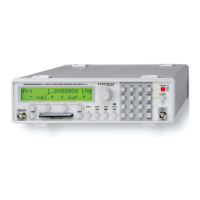43
Subject to change without notice
Introduction to the operation of HM8131-2
Basic instrument concept
List of abbreviations and symbols:
V
pp
peak-to-peak voltage
V
p
peak voltage
V
rms
root-mean-square voltage
DDS Direct digital synthesis
Sin sine
Tri triangle
Sqr square wave
+rmp positive ramp, sawtooth
–rmp negative ramp. sawtooth
Spc spectrum; selection of an arbitrary signal or noise
Functioning principle
The HM8131-2 is a direct digital synthesis signal generator . All
possible waveforms are stored in an EPROM or they are calcu-
lated. Not all waveforms are available up to 15 MHz due to the
limited speed of converters, memories and of the processor.
Signal waveforms
The HM8131-2 offers the choice of 6 predefi ned waveforms and
of an arbitrary waveform. The frequency and the amplitude of
sawtooth, (pos. and neg. ramp) , triangle, sine , and square wave
are selectable. The amplitude of the functions white noise resp.
pink noise is selectable. The arbitrary function may be freely
defi ned given the limitations of the instrument, a 4 K and a 16
K memory are provided.
Sawtooth
– Due to the digital principle of generation the frequency range
is limited to 100 μHz to 100 kHz
– Linearity error <1%
– Max. output voltage 20 V
pp
no load
– The ramp may be positive or negative
– Duration of negative or positive slope is approx. 45 ns.
Triangle
– Max. frequency 1 MHz
– Linearity error <1%
– Max. output voltage 20 V
pp
no load
Sine
– Max. frequency 15 MHz; resolution 100 μHz
– Max. output voltage 20 V
pp
no load
Square wave
– Max. frequency 15 MHz
– Resolution 100 uHz
– Rise time <10 ns
– Max. output voltage 20 Vpp no load
Arbitrary
– Max. frequency is 10 MHz at 40 MSa/s
– Amplitude resolution is 12 bits
– 4 K and 16 K memories are available
– a 4 K non-volatile and a 16 K volatile memory are provided
– The signal is fi ltered using a 7
th
order Bessel function with
a frequency of 10 MHz
– resolution 100 μHz
Introduction to the operation of HM8131-2
First time operation
Please note the following guidelines especially at
fi rst time turn-on:
– The mains connection is either to a 3 terminal connector with
a safety ground terminal or via an isolation trans-former of
class 2.
– No visible damages to the instrument
– Power cord undamaged
– No loose parts inside
– No test or other cables connected to the output terminal
. Check whether the LED adjacent to the output on/off
switch is extinct.
– First set the desired output signal at
– Check this signal by using a HAMEG scope
– A false output amplitude may damage any test, measure-
ment or other circuit connected to the output.
Self test
After turn-on the display will show in turn the following:
Instrument designation: The display shows type and version
number, e.g. HM8131-2 V 3.01:
*FUNCTION GENERATOR*
** HM8131-2 V3.01 **
Date:
The display shows the time and date as they are stored in the
instrument:
FRIDAY 24/01/03
16:55
Interface:
The interface type is displayed:
Communication Device
** default rs232 **
Reference frequency:
The display will indicate whether the instrument is programmed
for the internal or an external reference frequency:
Frequency Reference
Internal

